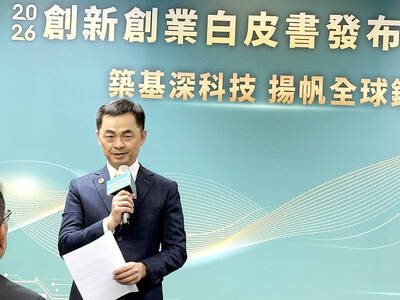Prices of industrial metals slid this week as the ongoing eurozone debt crisis dented demand for copper and tin, but oil futures rose thanks to geopolitical tensions over Iran.
BASE METALS: Major industrial metals prices declined, except for aluminum.
“Base metal price action is all about the politics at present,” Barclays Capital analyst Gayle Berry said. “The continued rise in Italian bond yields and growing concerns over a Europe-wide collapse pulled metals prices lower ... Even in spite of some supportive supply side news and positive Chinese import data, copper prices have continued to slide to the lowest since the end of October.”
By late Friday on the London Metal Exchange, copper for delivery in three months fell to US$7,623 a tonne from US$7,832 the previous week.
Three-month aluminum rose to US$2,169 a tonne from US$2,143.
Three-month lead dropped to US$1,996 a tonne from US$2,031.
Three-month tin decreased to US$21,700 a tonne from US$22,100.
Three-month nickel retreated to US$18,350 a tonne from US$18,550.
PRECIOUS METALS: Gold prices won a small lift as the precious metal benefited from its status as a safe haven in times of economic unrest and geopolitical tensions.
“Given the ongoing high uncertainties and the current risk aversion, gold should remain well supported,” Commerzbank analyst Carsten Fritsch said. By late Friday on the London Bullion Market, gold nudged upward to US$1,773 an ounce from US$1,749 the previous week.
Silver fell to US$33.77 an ounce from US$33.95.
On the London Platinum and Palladium Market, platinum edged up to US$1,628 an ounce from US$1,623.50.
Palladium dropped to US$651 an ounce from US$682.
OIL: Crude oil prices advanced as concerns over Iran’s nuclear plans offset eurozone worries.
By late Friday on London’s Intercontinental Exchange, Brent North Sea crude for delivery in December jumped to US$114.22 a barrel from US$111.40 a week earlier.
On the New York Mercantile Exchange, West Texas Intermediate, or light sweet crude, for December, rallied to US$98.82 a barrel from US$93.92.

CHIP RACE: Three years of overbroad export controls drove foreign competitors to pursue their own AI chips, and ‘cost US taxpayers billions of dollars,’ Nvidia said China has figured out the US strategy for allowing it to buy Nvidia Corp’s H200s and is rejecting the artificial intelligence (AI) chip in favor of domestically developed semiconductors, White House AI adviser David Sacks said, citing news reports. US President Donald Trump on Monday said that he would allow shipments of Nvidia’s H200 chips to China, part of an administration effort backed by Sacks to challenge Chinese tech champions such as Huawei Technologies Co (華為) by bringing US competition to their home market. On Friday, Sacks signaled that he was uncertain about whether that approach would work. “They’re rejecting our chips,” Sacks

NATIONAL SECURITY: Intel’s testing of ACM tools despite US government control ‘highlights egregious gaps in US technology protection policies,’ a former official said Chipmaker Intel Corp has tested chipmaking tools this year from a toolmaker with deep roots in China and two overseas units that were targeted by US sanctions, according to two sources with direct knowledge of the matter. Intel, which fended off calls for its CEO’s resignation from US President Donald Trump in August over his alleged ties to China, got the tools from ACM Research Inc, a Fremont, California-based producer of chipmaking equipment. Two of ACM’s units, based in Shanghai and South Korea, were among a number of firms barred last year from receiving US technology over claims they have

BARRIERS: Gudeng’s chairman said it was unlikely that the US could replicate Taiwan’s science parks in Arizona, given its strict immigration policies and cultural differences Gudeng Precision Industrial Co (家登), which supplies wafer pods to the world’s major semiconductor firms, yesterday said it is in no rush to set up production in the US due to high costs. The company supplies its customers through a warehouse in Arizona jointly operated by TSS Holdings Ltd (德鑫控股), a joint holding of Gudeng and 17 Taiwanese firms in the semiconductor supply chain, including specialty plastic compounds producer Nytex Composites Co (耐特) and automated material handling system supplier Symtek Automation Asia Co (迅得). While the company has long been exploring the feasibility of setting up production in the US to address

OPTION: Uber said it could provide higher pay for batch trips, if incentives for batching is not removed entirely, as the latter would force it to pass on the costs to consumers Uber Technologies Inc yesterday warned that proposed restrictions on batching orders and minimum wages could prompt a NT$20 delivery fee increase in Taiwan, as lower efficiency would drive up costs. Uber CEO Dara Khosrowshahi made the remarks yesterday during his visit to Taiwan. He is on a multileg trip to the region, which includes stops in South Korea and Japan. His visit coincided the release last month of the Ministry of Labor’s draft bill on the delivery sector, which aims to safeguard delivery workers’ rights and improve their welfare. The ministry set the minimum pay for local food delivery drivers at